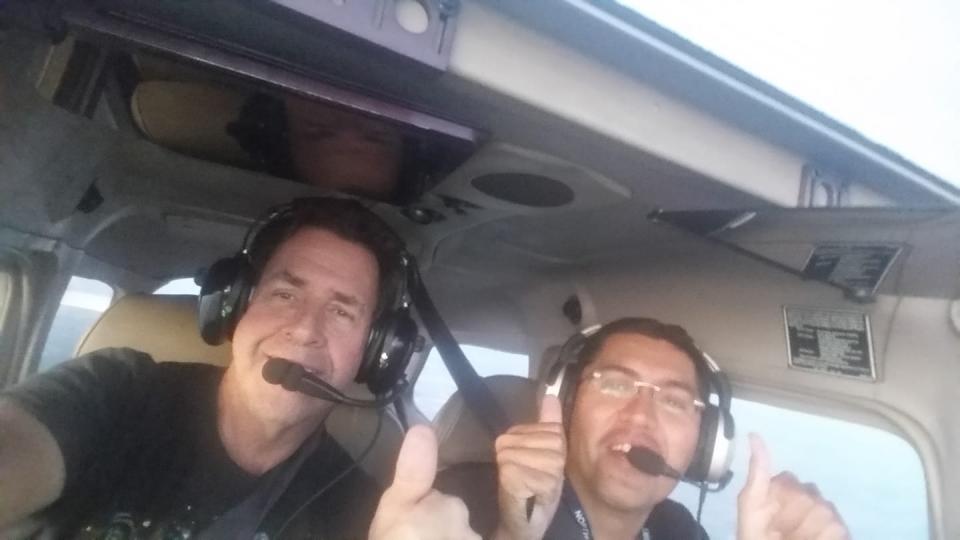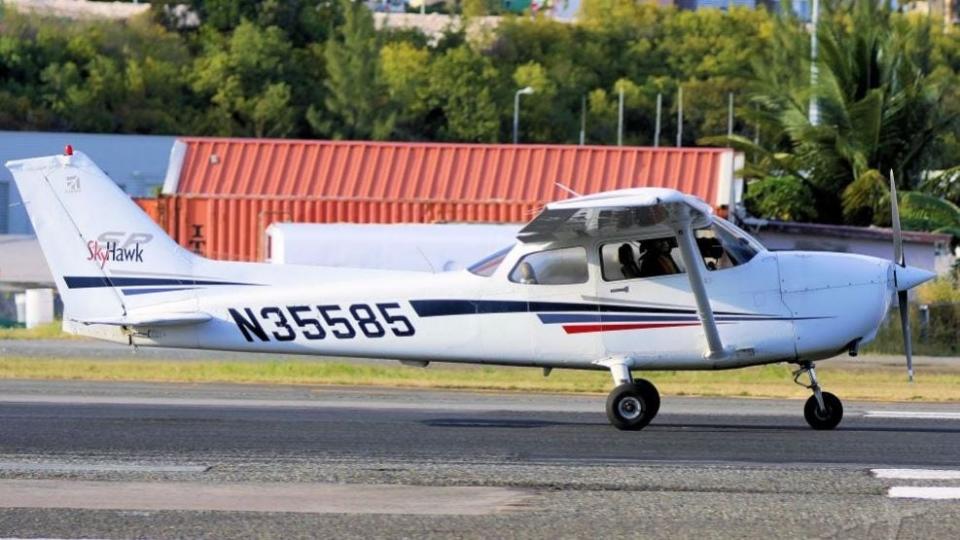What went wrong in Elkton plane crash?
![Terry Umbenhaur and Bassam Sameh Labib were both in a Cesna that landed and flipped in a potato field in Elkton in July. The NTSB is investigating the cause of the crash. [SJCSO]](https://s.yimg.com/ny/api/res/1.2/63aG21BoKNQS51Vitivu8w--/YXBwaWQ9aGlnaGxhbmRlcjt3PTEyNDI7aD05MzI-/https://media.zenfs.com/en/the-st-augustine-record/dde5b5bcfd7a1190f875895e3538bfcc)
EDITOR'S NOTE: The follow-up National Transportation Safety Board report for the second crash clarified that Terry Umbenhaur was the student practicing emergency scenarios with flight instructor Bassam Elias. After doing some maneuvers, the pair said Elias took the controls to demonstrate how to handle an engine fire and went down to 100 feet, recovered and climbed back up. He then let Umbenhaur try until the instructor felt the situation was in peril and re-took control before impact. Elias said he was following the instructions of the flight school's designated pilot examiner who insisted on teaching certified flight instructor applicants to take the plane down to 100 feet for emergency training.
The NTSB report included the Florida Flyers Flight Academy's July 18, 2019, operator/owner statement-safety recommendation:
"Operators Operations Manual has previously and currently uses minimum altitude allowed for simulated emergency procedures. This minimum altitude is clearly represented in standardization training and notated in operator's standards manual "Do not descend below 500 feet." Company operation manual has defined the determination in all company aircraft as such "Anytime a Florida Flyers flight instructor is aboard a Florida Flyers training flight acting as the student's instructor, the flight instructor will be considered the pilot-in-command of that flight." This accident could have been prevented if instructor adhered to company-established standards and procedures."
ORIGINAL STORY
The FHP narrative about a July plane crash in Elkton is short and straightforward.
Terry Umbenhaur was the “driver” of a 1979 Cesna 172 that landed and flipped upside down in a potato field in Elkton at 9:21 a.m. The crash was “due to pilot error,” the report said.
But Umbenhaur told The Record this week the narrative on the report is misleading and fails to tell the whole story.
The official findings of the National Transportation Safety Board’s investigation into what exactly led to the crash have yet to be published, according to NTSB spokesman Christopher O’Neil. But Umbenhaur said he was not solely responsible for what happened. He shared his and side of the story with The Record on Tuesday, the same story he told investigators who are looking into what caused the crash.
What happened?
Bassam Sameh Labib, 27, was listed as Passenger No. 1 on the FHP report, but according to Umbenhaur, Labib was a Certified Flight Instructor leading the flight on July 14. Labib, a CFI with the Florida Flyers Flight Academy in St. Augustine, was taking Umbenhaur through a training session and teaching Umbenhaur to become a CFI himself.
While in the air, Labib was walking Umbenhaur through emergency landing drills that would simulate what to do in the event of engine failure.
Then the drills became real.
According to Umbenhaur, Labib put the engine in idle and took the Cesna down to 50 feet to demonstrate what to do if the engine goes out and you have to make an emergency landing. Umbenhaur said the low altitude they were flying at was a violation of the school’s safety protocol.
“I was kind of scared about it,” Umbenhaur told The Record on Tuesday. “The school says don’t go below 500 feet unless you are going to go to a runway to land. The reason you do that is that you have enough time in case something goes wrong, you still have time to recover.”
Labib, an instructor with about 1,200 flight hours according to Umbenhaur, then elevated again and told Umbenhaur to take over the controls.
“When I did it, we got down to 200 feet, and I told him this is not working out. He said ‘just keep going,’” Umbenhaur said.
When the plane got down to 100 feet, Labib told Umbenhaur he would take back the controls, Umbenhaur said. But when Labib took over and tried to restart the engine and elevate again, nothing happened and the plan continued to get closer to the ground below, Umbenhaur said.
The plane eventually touched down safely in a potato field near Huff Road in Elkton, but as the plane slowed down, the front landing gear hit a ditch in the field and the plane flipped over.
Labib and Umbenhaur were left hanging upside down in the heavily damaged plane but weren’t hurt.
“We got really lucky,” Umbenhaur said. “It was scary. It’s definitely something I don’t want to do again.”
The crash happened about two hours after another plane crash in nearby Hastings that left two brothers seriously injured.
Who’s at fault?
Despite the claims of Umbenhaur, the official determination as to who is at fault and what led to the crash will not be known until the NTSB completes its investigation. O’Neil said Tuesday that could take up to 18 months. The NTSB investigator in charge of the case said the crash remains an ongoing investigation and declined to offer further information.
Jeffrey Ludwig, a Jacksonville-based aviation attorney and Certified Flight Instructor for more than 30 years, said part of the job of the investigator will include establishing who had control of the airplane at the time of the crash.
“We don’t know that for sure. It could be one or the other,” said Ludwig, adding that there are controls in front of both seats of the plane.
Speaking in general and not about the crash, Ludwig said in most cases where there is a student and CIF in the plane at the same time, the flight instructor would be responsible.
“It could be a dual-decision making error, but when you are giving flight instruction, and this is not a legal term, but it is kind of your baby,” Ludwig said. “You’re getting paid to give instruction and inherent in that is that it is going to be safe instruction.”
The Record tried to contact Labib through Facebook messenger to hear his version of the events, but as of Thursday afternoon, he had not responded.
Shawn Marshall, CEO/Chief Flight Instructor at Florida Flyers Flight Academy, also did not respond to a request for comment. Marshall told other media outlets after the crash he does not comment on ongoing investigations.
Umbenhaur, 31, said a week after the crash, Labib had left the school. He was not sure if Labib left on his own accord or was fired.
Since the crash, Umbenhaur was forced to move to another flight school in the Tampa area to pursue his CFI license because Labib was one of just two CFI instructors at the school.
"I think the school is fine, I think this guy just didn’t follow some of the rules that the school had, which turns out is not really a good idea," Umbenhaur said.
Waiting game
Eventually Umbenhaur hopes to work for a big regional airline, but for now, it's a waiting game.
"I am just waiting for the FAA to say something about it," he said. "They still haven't made any decisions or requests about it. I thought it would be finished by now."
With no flight recorder onboard to document exactly what happened on the plane that day, it's likely the investigation will hinge largely on the statements of the two men onboard the plane at the time of the crash.The investigator that came to the crash site that day said it would take about three weeks, but as of Friday, it has been nearly five weeks since the crash. Umbenhaur, who said he currently does not have any flight restrictions, hopes that everything will be cleared up soon and his name will be cleared before he starts to look for jobs next year.
"When I go and hopefully work for one of the regional airlines, I want to make sure it’s something that is not unclear," he said.


This article originally appeared on St. Augustine Record: What went wrong in Elkton plane crash?

